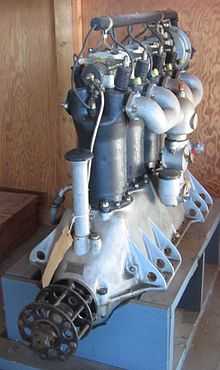Hall-Scott
| Industry | Engine manufacturers |
|---|---|
| Fate | Dissolved |
| Founded | Berkeley, California (1910) |
| Founder |
Elbert J. Hall Bert C. Scott |
| Defunct | 1960 |
Hall-Scott Motor Car Company was a Berkeley, California-based manufacturing company. It was among the most significant builders of water-cooled aircraft engines prior to World War I.
Company history
1910–1921
The company was initially founded in 1910 by Californians Elbert J. Hall and Bert C. Scott to manufacture gasoline-powered rail cars. Hall was the engineer, while Scott was the business executive. They produced their first rail car in 1909, which they sold to the Yreka Railroad, and the newly named Hall-Scott Motor Car Company was launched, with manufacturing in Berkeley, California in 1910 and with headquarters for a short time in San Francisco. The rail car business was slow, but some were sold as far away as China. Interurban electric railway cars were built for railroads such as the electrified Sacramento Northern, which ran trains from adjacent Oakland to Sacramento and Chico.
Hall-Scott also manufactured aircraft engines for commercial and military aviation, also beginning in 1910. These engines possessed a remarkable power-to-weight ratio for the era, using an overhead cam, overhead valves, hemispherical combustion chamber, and extensive use of aluminum. Their engines also benefited from manufacturing cost efficiency by sharing parts and dimensions between types. Hall became associated with the design, joining forces with Jesse Vincent of Packard, of the famous "Liberty" airplane engine, which has a number of features that are discernibly Hall-Scott. Even so, Hall-Scott was too small a business to participate in the manufacture of the Liberties.
1921–1945
Shortly after World War I, around 1921, Hall-Scott dropped its aero engine and rail car product lines, and expanded into building engines for tractors, trucks, boats, and stationary applications. The firm produced several hundred thousand two-speed rear axles, the Ruckstell Axle, for Ford's Model T through the mid-1920s. American Car and Foundry purchased Hall-Scott in 1925 and used its engines in its buses and boats. In 1931, one of the firm's most famous and important products, the Invader marine engine entered production. The company survived the Depression and then attained its highest production rates and employment numbers in World War II by building engines for a variety of military products, including a tank retriever, the M-26/M-26A1, and the Higgins boat (LCVP).
E. J. Hall took the job of developing the valve system of Duesenberg racing engines in 1921 and developed new cam lobe profiles which improved both engine reliability and power output. His research provided an understanding of the importance of the gradual opening and closing of valves and the effect this had on valve spring durability in high speed engines. The designs he specified gave Duesenberg an immediate advantage and were quickly copied and applied to all high speed engines using poppet valves to the present day. This work was done in Berkeley, California the home of Hall-Scott so it is a reasonable assumption that E. J. Hall used his company's resources, though not absolutely indicated.[1]
1945–1960
Some post World War II ACF-Brill buses manufactured in Philadelphia and purchased by Greyhound and Trailways were often equipped with Hall-Scott engines. Its last all-new motor, the 590, came out in 1954. ACF also divested itself of Hall-Scott in 1954, and the firm became independent, now calling itself Hall-Scott, Inc. Engine sales remained at low levels, less than 1000 per year in the 1950s, so the company tried to boost sales by purchasing a number of firms outside engine making. Not changing its financial performance appreciably, Hall-Scott accepted purchase of its engine division by Hercules Motors Corporation in 1958 and closed the Berkeley plant. The final engines bearing the Hall-Scott name were produced by Hercules in Canton, Ohio in the late 1960s. Hall-Scott disappeared as a discrete company when the non-engine division of the company merged with Dubois Holding Company in 1960.
Museum exhibits
Two Hall-Scott interurban coaches from the former Sacramento Northern Railroad are located at the Western Railway Museum at Rio Vista, California (serial numbers 1019, 1020). The 1020 is now restored to its original coach/trailer configuration.
Nevada Copper Belt 21 (1910 100 hp) is stored "serviceable" at the California State Railroad Museum in Sacramento.
The body of Nevada Copper Belt 22 (ex Salt Lake & Utah 503 1913 150 hp) is at the Nevada State Railroad Museum in Carson City.
Select products

- Hall-Scott A-2 (V-8 aero engine)
- Hall-Scott A-3 (V-8 aero engine)
- Hall-Scott A-5 (straight-6 aero engine, OHC, 165 hp)
- Hall-Scott L-4 (straight-4 aero engine, 125 hp).[2]
- Hall-Scott L-6 (straight-6 aero engine, 200 hp)
- Hall-Scott A-7 (straight-4 aero engine, OHC)
- Hall-Scott A-8 (V-12 aero engine, basis for the Liberty)
- Hall-Scott Invader (straight-6 marine engine, OHC)
- Hall-Scott Defender (V-12 marine engine, OHC) (used in the Fairmile A and B motor launches (Navy patrol boats)
- Hall-Scott 400 (straight-6, truck engine, OHC)
- Hall-Scott 440 (variant of the 400, OHV 1090in3; largest gasoline engine in any WW2 military truck)[3])
- Hall-Scott 590 (straight-6, truck & bus engine, OHC)
References
- ↑ The Golden Age of the American Racing Car, Griffith Borgeson, Bonanza, New York, 1966, PP123
- ↑ Society of Automotive Engineers. Transactions of the Society of Automotive Engineers, Volume 13, Issue 2. p. 264.
- ↑ Berndt, Thomas. Standard Catalog of U.S. Military Vehicles 1940-1965 (Iola, WI: Krause Publications, 1993), p.125
- Powerhouse Museum Collection : Hall-Scott Motor Car Co.
- Berndt, Thomas. Standard Catalog of U.S. Military Vehicles 1940-1965. Iola, WI: Krause Publications, 1993.
- Bradford, Francis & Ric Dias, Hall-Scott; The Untold Story of a Great American Engine Maker (SAE, Int'l: Warrendale, 2007)
- Dias, Ric, History of Hall-Scott
- Gunston, Bill, World Encyclopaedia of Aero Engines (Patrick Stephens: Wellingborough, 1983), p. 73
- Western Railway Museum Wikipedia
External links
| Wikimedia Commons has media related to Hall-Scott aircraft engines. |
| ||||||
| ||||||||||||||||||||||